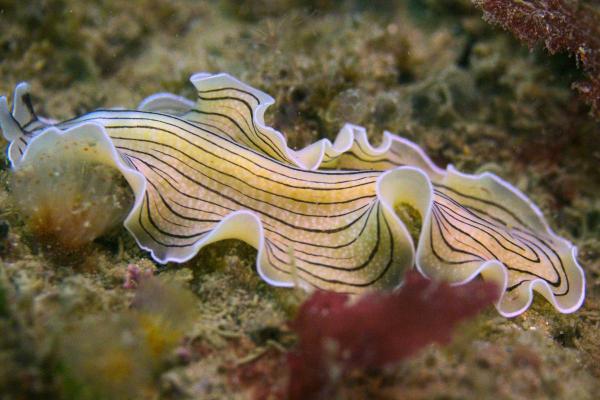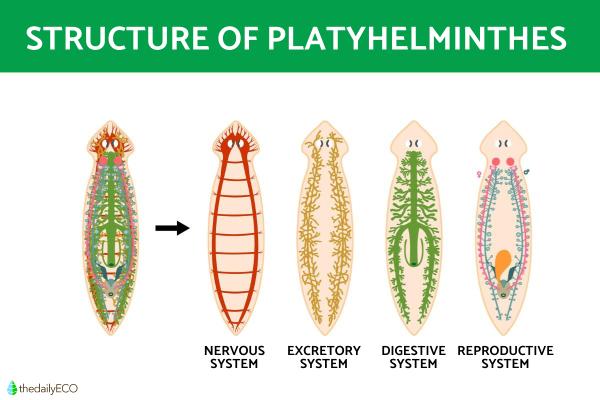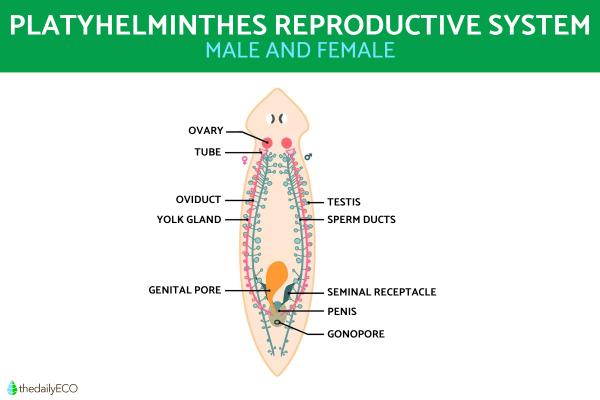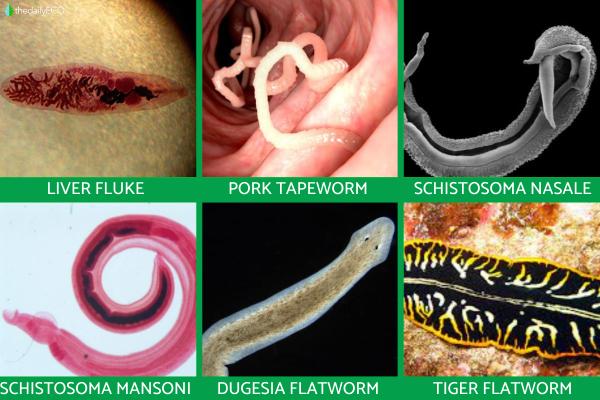
Platyhelminthes is a phylum of invertebrates commonly known as flatworms. We may be aware of other types of bilateral invertebrates known as worms, but it is difficult to group them together taxonomically. For this reason, we have phyla like Platyhelminthes which group animals according to certain key characteristics. One of the key characteristics of flatworms is their lack of a coelom or body cavity. It is this which provides their flattened morphology. Due to their relatively simply bodies, they need to get food and reproduce in different ways to other animals. Learn more about their behaviors as thedailyECO looks at Platyhelminthes characteristics and examples with photos.
What are Platyhelminthes and their characteristics?
Platyhelminthes is a phylum of invertebrates that are commonly known as flatworms. The reason for this is their lack of a body cavity (coelom) which means they are not only flattened in appearance, but they are relatively simple organisms. There are approximately 2,000 individual species within this phylum.
Some of the characteristics of Platyhelminthes are the following:
- They have bilateral symmetry: their body is flattened and shaped somewhat like the sole of a shoe.
- They use protonephridia: their excretion occurs through these organ, which are primitive excretory organs similar in function to kidneys.
- They are hermaphrodites: or at least most of them are. This means they have both male and female sex organs.
- They lack a circulatory system and a respiratory system: they only absorb oxygen from the humidity of the environment.
- They do not have internal body cavities: they only have digestive tracts. These cavity-less animals are called acoelomates.
- It has a nervous system: it consists of two cords that run vertically through the body and join at the front.
- They have interneurons: in fact, they are the simplest animals that have these types of neurons which communicate between different bodily systems.
- They can parasitize humans: they have great medical importance. Learn more about the kingdom to which many parasites belong with our article on what is the Protista kingdom?
If you want to know about other invertebrate worms which belong to other phyla, check out our article on the characteristics and examples of ribbon worms.

Platyhelminthes behaviors
We know a little about the physical forms of flatworms, but we can learn more about their habitat and their behaviors within them. These flatworms live in humid spaces that contain oxygen, meaning their distribution is varied. Generally speaking, the habitats of Platyhelminthes are one of the following:
- Aquatic environments: such as oceans, rivers or freshwater bodies.
- Humid terrestrial and aerial environments: such as the bodies of other animals, especially if they are large parasites that need other hosts to live. They can do so both in their larval and in their adult stages.
What do Platyhelminthes eat?
Small Platyhelminthes lack a digestive tract, only absorbing food from the outside environment. Their digestive system is incomplete and they do not have an anus. In addition, they have a digestive system with an opening to the outside that is divided into several channels so that it can reach all the tissues, without needing a circulatory system to transport them.
Another type of feeding is through the use of cilia, small, short structures that resemble eyelashes. They use these cilia to feed on detritus. Finally, there are some flatworms that can be predators of invertebrates.
If you want to know more about how different animals feed, take a look at our article explaining the difference between predators and prey.
How do Platyhelminthes reproduce?
As we have mentioned in the characteristics of Platyhelminthes, most of them are hermaphrodites. This means they have both male and female reproductive organs. Despite being one of the simplest organisms in existence, their reproductive system is very complex. We explain the reproductive organs of the male and the female respectively flatworm in more detail below.
- Flatworm male reproductive system: has a copulatory organ known as a cirrus through which spermatozoa are released from the testicles. They have efferent vessels, as well as one deferent, seminal vesicle, prostate gland and ejaculatory duct.
- Flatworm female reproductive system: has a canal called ootype where the eggs and various hormones are discharged. It also has a uterus, vitellogenic glands, genital pore, seminal receptacle and Laurer's canal, a type of vestigial vagina.
Flatworms from the phylum Platyhelminthes can also carry out different reproduction strategies, since they can practice sexual and asexual reproduction:
- Sexual reproduction: being hermaphrodites they can self-fertilize. In this case, their sexual reproduction is carried out through the union of gametes via internal fertilization.
- Asexual reproduction: other Platyhelminthes can reproduce asexually by fission, where they split into two. They can also reproduce via parthenogenesis, where an unfertilized egg splits into two.
Our related article explains more about the types of asexual reproduction in plants and animals.
Reproduction of parasitic Platyhelminthes
Endoparasite flatworm species have very complex life cycles. They alternate the type of reproduction between hosts to complete their life cycle. Asexual reproduction occurs in the intermediate host, which is usually an invertebrate. Sexual reproduction occurs in the definitive host, which is a vertebrate. The different phases generate different diseases in the parasitized organism.
In most cases, the adult flatworm is formed directly. In parasitic flatworm species, they carry out indirect development, with several stages including larvae and eggs.
Learn about another invertebrate which develops thanks to larvae and eggs with our guide to the life cycle of flies.

Examples of Platyhelminthes species
There are different types of flatworms, but the most traditional classification of Platyhelminthes allows us to distinguish them and group them into four different classes:
- Turbellaria: free-living flatworms known as planarians.
- Monogenea: parasites of fish and amphibians.
- Trematoda: also known commonly as flukes.
- Cestoda: as adults they take the form of parasitic tapeworms.
Now that we have seen that there are different types of Platyhelminthes grouped according to different classes, below we present some example species of each. Photos of these Platyhelminthes can be seen below.
Liver fluke (Fasciola hepatica)
This flatworm has suckers on its head and attaches itself to the liver of various mammals, including livestock such as sheep and cattle. They can contract these parasites when grazing by coming into contact with freshwater snails, which are hosts that transmit the disease. This has repercussions for the livestock industry.
Pork tapeworm (Taenia solium)
Another flatworm which is known to attack livestock, they have a complex life cycle. In their worm stage they are attached with mouth hooks to the stomach of mammals, including humans. After the head, they are made up of several segments. Each one contains sexual organs, with an enormous potential to continue reproducing.
In younger stages, these flatworms are found in the muscles. Eggs can lodge in the brain, causing cysticercosis. It is transmitted to humans when they eat undercooked and infested pork. It can also be transmitted by eggs from feces.
Schistosoma nasale
This parasitic platyhelminth is also transmitted by freshwater snails. It lodges in the respiratory system of cattle, causing a runny nose and labored breathing. For this reason, its parasitosis is often known as snoring disease.
Schistosoma mansoni
In humans, it causes schistosomiasis. This disease results in skin conditions, as well as damage to the lungs and intestines. This type of disease can be contracted through water containing the egg stage of these flatworms that enter humans through the skin. The eggs are released through feces and are carried by snails.
Dugesia flatworm (Dugesia spp.)
These planarians are characterized by having a triangular head with two eyes. They are found in fresh water and there are several species. In addition, they have a great capacity for regeneration, something which is very important for science. For example, if they are cut into pieces, new planarians with a head and a tail will be generated.
Tiger flatworm (Pseudoceros dimidiatus)
This yellow and black planarian flatworm measures 8 centimeters in length. It is very brightly colored and has folds on its edges. It is a free-living marine organism that lives in the Indo-Pacific.
Although quite different, you can learn about a class of annelid worms with our article asking what are polychaetes?

If you want to read similar articles to Platyhelminthes Characteristics and Examples, we recommend you visit our Wild animals category.
- Faculty of Sciences of the University of the Eastern Republic of Uruguay. (2009). Phylum Platyhelminthes. Retrieved from http://zoologia.fcien.edu.uy/practico/03%20PLATYHELMINTHES&NEMERTINA.pdf
- University of Las Palmas de Gran Canaria. (2014). Platyhelminthes: Generalities and classification. Retrieved from https://www2.ulpgc.es/hege/almacen/download/48/48207/leccion_11_0607.pdf
- Beatty, R., Beer, A., & Deeming, C. (2010). The nature book. Dorling Kindersley.